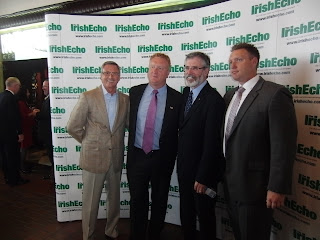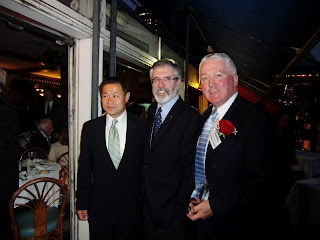
Joseph Smyth, mise and Terry O Sullivan
The first thing you notice when you get out of the car at the South Street Seaport in New York are the massive sailing ships. The Peking, built in 1911, with its four enormous masts and rigging is an impressive sight and dominates the landscape. And there are other sailing ships dating from even earlier times. The South Street Seaport sits on the site of the original port of New York and part of it is Pier 17.
That was my destination last Wednesday evening. Me and your man were on our way to Harbour Lights, a restaurant, where the Irish Echo was holding an event to honour Irish America’s labour legacy – Irish Labour 50.
The Pier is now a tourist centre and part of a designated historic area which includes a Museum, exhibition galleries, a working 19th-century print shop, an archeology museum, a maritime library, and much more, including a small fleet of privately owned sailing ships.
Harbour Lights looks out over the East river and at night is lit by the lights of the Brooklyn Bridge.
The contribution of the Irish in America to the labour movement has been significant and the Irish Echo event was recognition of this. It was an opportunity to pay tribute to current labour leaders and activists, and for me to say thank them for their ongoing contribution to the peace process.

Kathleen Curtain from the Kingdom
The restaurant was packed to overflowing. Your man complained that he could not get a seat. I ignored him and went off to talk to Kathleen Curtain an old friend from Kerry who was amazingly magnanimous about Dublin’s victory over the Kingdom. I was also delighted to see Marian and Patti Reynolds. Great people all.
In my remarks I took the opportunity to extend warm greetings from Martin McGuinness and to assure the audience of his and Sinn Féin’s commitment to secure the right to vote in future Presidential elections for Irish citizens in the north and those living abroad.
The Irish involvement with the labour movement in the USA goes back over a 150 years. The period during and after the great hunger saw a huge influx of Irish and this gave a boost to efforts to organise working people.
Those Irish built the roads and canals, the sewers and the railroads, the buildings and the mines – the infrastructure of this vast new emerging United States of America. It was a hugely difficult time. Poverty and hardship were the common experience of millions of Irish. There was significant discrimination and I recalled a sign given to me some years ago which dates from that dark period and which declares, ‘No Irish Need Apply’.
Irish workers were not the only workers to face the challenges of exploitation and adversity. It was a time when workers had no rights. They were hired and fired by employers, who often had the power of life or death as witnessed in the oppression of the Molly Maguires.
The children of workers had no childhood and no future. They too worked from a young age. The great American writer Jack London described a child worker; ‘He did not walk like a man. He did not look like a man. He was a travesty of the human. It was a twisted and stunted and nameless piece of life that shambled like a sickly ape, arms loose-hanging, stoop shouldered, narrow-chested, grotesque and terrible.’
Trade Unions were the means by which working people could demand improvements in working conditions and wages. And the Irish helped establish many trade unions and worked hard to make them a success.


I reminded the audience that one of our greatest leaders James Connolly was a hugely influential trade union activist in the United States, as well as in Ireland. Connolly spent 7 years of his life here and he helped found and organise the ‘Independent Workers of the World’ and campaigned tirelessly for workers rights. He understood the importance of workers standing together, united against injustice and oppression.
And he articulated the connection between British colonialism and sectarianism in Ireland, and the importance of workers taking a stand against the British presence. He famously wrote: ‘The cause of Labour is the cause of Ireland; the cause of Ireland is the cause of Labour.’
He was prepared to put his life on the line in pursuit of his beliefs and in 1916 he was executed by the British for helping to lead the Easter Rising. But his death did not stop his ideas from taking root.
The Proclamation, which Connolly played a key role in writing, reflects his beliefs. It is a freedom charter. It guarantees religious and civil liberty and is avowedly anti-sectarian. It promotes equal rights and equal opportunities for all citizens. And at a time when women in most countries did not have the vote, the government of this new Republic was to be elected by the suffrages of all her men and women. The Proclamation is a declaration of social and economic intent for a rights based society in which the people are sovereign.
It is, as this blog has said many times, for Irish republicans today our mission statement for the 21st century.
There were also among the audience Labour leaders who have stood shoulder to shoulder with us in the peace process in Ireland. Their role and that of Irish America and especially of the Trade Unions, has been hugely influential and invaluable.
The fact is that there would be no peace process at this time in Ireland if the trade union movement had not been part of the Irish American lobby, which in the early 1990’s created the possibility of cessations and negotiations and agreements.
However, the great historic challenge facing the people of Ireland has yet to be resolved – British involvement in our country and the reunification of Ireland.
Uniting Ireland makes economic sense; it makes political sense; it makes common sense. And we need Irish America to stay with us as we seek to advance toward the achievement of this goal.

Thanking Terry for his help with the Peace Process
At the end of the speeches I had the honour to make a number of presentations. One especially was for the President of LiUNA – The Labourer’s International Union of North America.
I have known Terry O Sullivan, whose family are from Kerry, for many years now. He has been a good friend and supporter of the Irish peace process.
I had to leave early to go back to another event but it was clear from the boisterous banter that the labour activists and their families were intent on having a great night.
As we left your man was complaining again. This time it was because he was leaving. There is no pleasing some people.

With John Liu New York City Comptroller



.jpg)
Comments
A good story to tell, and one close to my heart, Labour that is.
Uniting Ireland makes economic sense- So true, in this time of social concerns. The Irish labour movement is a great story to tell.
Today the challenges of exploitation and adversity is still with us. Thehist Irish understands this history. As a international business specialist, I understand the historic view and needs that face an Irish nation for new International Unions and investments. "Workers standing together, united against injustice and oppression." well said Gerry, good and as James Connolly said: "Without the power of the Industrial Union behind it, Democracy can only enter the State as the victim enters the gullet of the Serpent." Great Job and good promotion of Martin as well, take care..